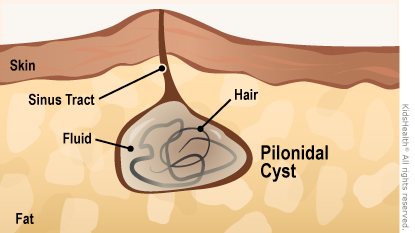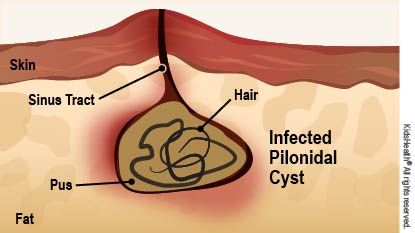Can a Pilonidal Cyst Cause Lower Back Pain
What Is a Pilonidal Cyst?
A pilonidal cyst is a fluid-filled sac under the skin in the lower back, near the pucker of the buttocks. Some aren't visible, while others tin look like a small pit or dimple in the pare.
They don't normally cause problems or demand treatment unless they become infected. A pilonidal (pie-luh-NIE-dul) cyst that's infected is called a pilonidal abscess.
What Are the Signs & Symptoms of a Pilonidal Cyst?
A cyst that isn't infected might not cause any symptoms. Someone with an infected cyst can take:
- pain, redness, and swelling in the area of the cyst
- pus or blood draining from a small opening (chosen a sinus tract) in the skin over or virtually the cyst
- a fever
What Causes a Pilonidal Cyst?
Doctors think that pilonidal cysts form when loose pilus and expressionless pare cells become trapped under the skin. When nosotros sit down or bend, peel in the tailbone area stretches. This tin can cause hairs to break off. As a person moves, the broken hairs and dead skin cells can get pushed nether the skin. The allowed system treats the hair and dead peel cells as strange, and forms a cyst around them that fills with fluid.

Who Gets Pilonidal Cysts?
Anyone can get a pilonidal cyst, but they're most common in immature men.
A person can be more than probable to develop a pilonidal cyst if they:
- are born with a dimple or pit in their tailbone area
- spend a lot of time in a sitting position
- are overweight
- have a lot of body hair, especially if it'southward thick or coarse
- wear tight clothing that presses on the tailbone area
- have family unit members with a pilonidal cyst
How Is a Pilonidal Cyst Diagnosed?
Doctors ordinarily diagnose a pilonidal cyst based on where it is and how it looks and feels.
How Is a Pilonidal Cyst Treated?
A cyst that doesn't cause symptoms might non need treatment.

Handling for a pilonidal abscess depends on how severe the infection is. Home care with sitz baths and warm compresses tin can care for balmy infections. If abode care doesn't work or the infection is more serious, doctors might make a modest cut to drain the abscess. They might prescribe antibiotics if the infection spreads to skin around the cyst.
How Tin can Parents Help?
To care for a pilonidal cyst at home:
- Clean the surface area as directed.
- If the doc tells yous to, regularly remove hair from the area by shaving or using a hair removal product. Permanent hair removal, such as laser hair removal, also might be an choice.
- Remind your child to avoid sitting for long periods of time.
- Suggest that your child sleep on their side or tum, which tin exist more than comfortable.
If your child had a pilonidal cyst drained:
- If the medico prescribed antibiotics, requite them equally directed.
- Change or remove the bandage every bit recommended.
- Your child shouldn't take a bath or swim until the doctor says it's OK.
What Else Should I Know?
After the infection heals, the doctor may suggest surgery to remove the cyst. Even after surgery, pilonidal cysts sometimes come up dorsum. Keeping the area make clean and free of hair can help prevent an infection and new cysts.
Date reviewed: January 2020
Source: https://kidshealth.org/en/parents/pilonidal-cyst.html
0 Response to "Can a Pilonidal Cyst Cause Lower Back Pain"
Post a Comment